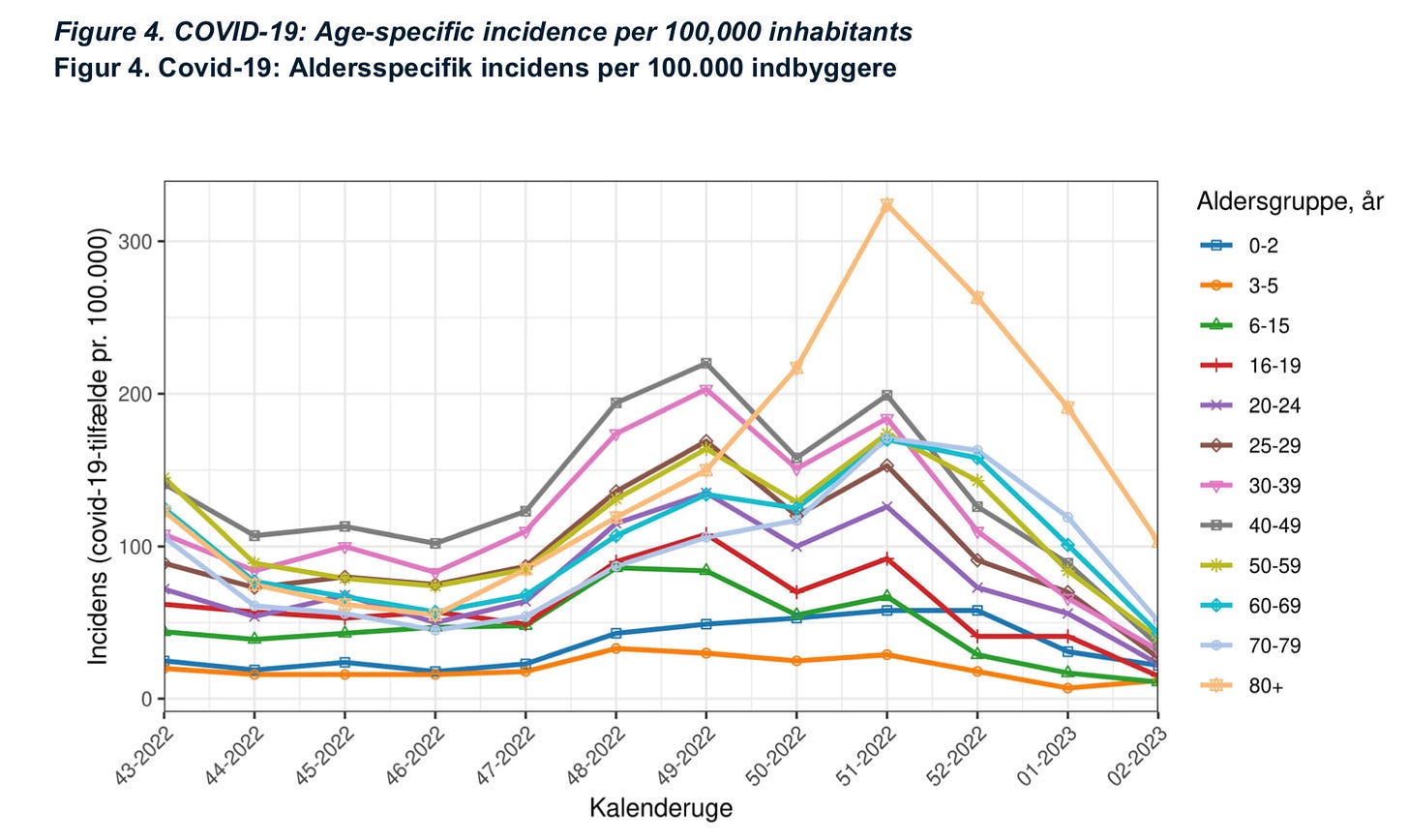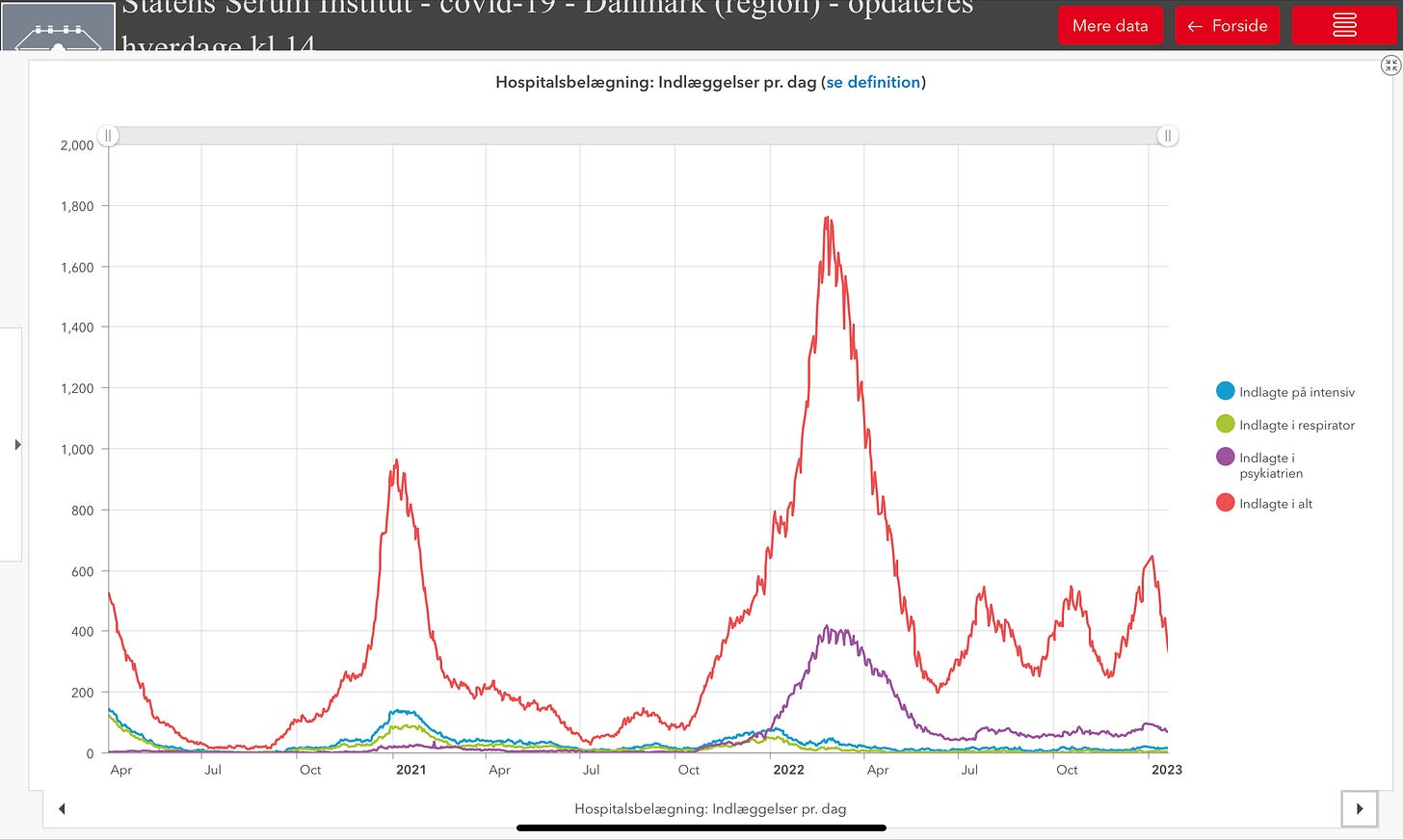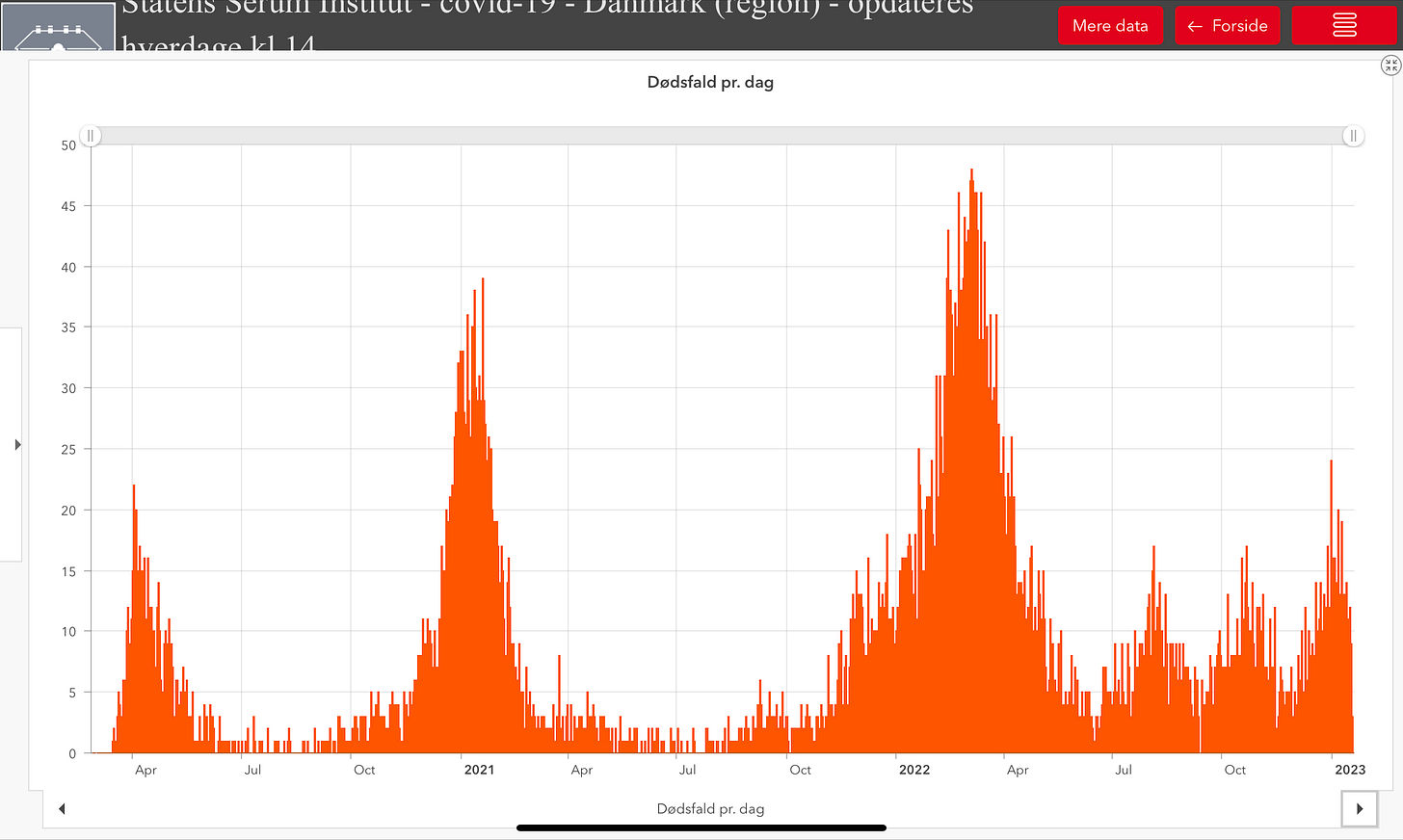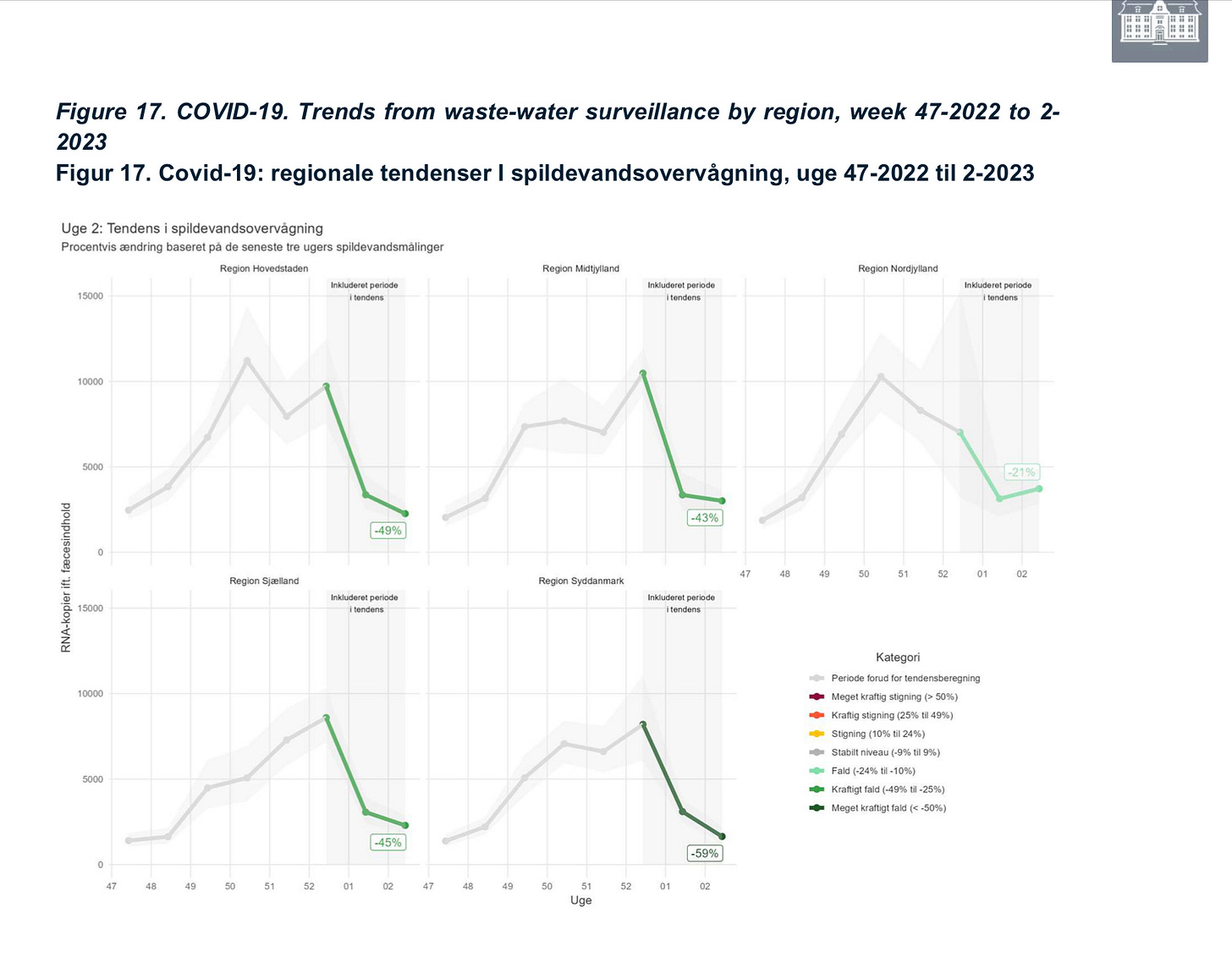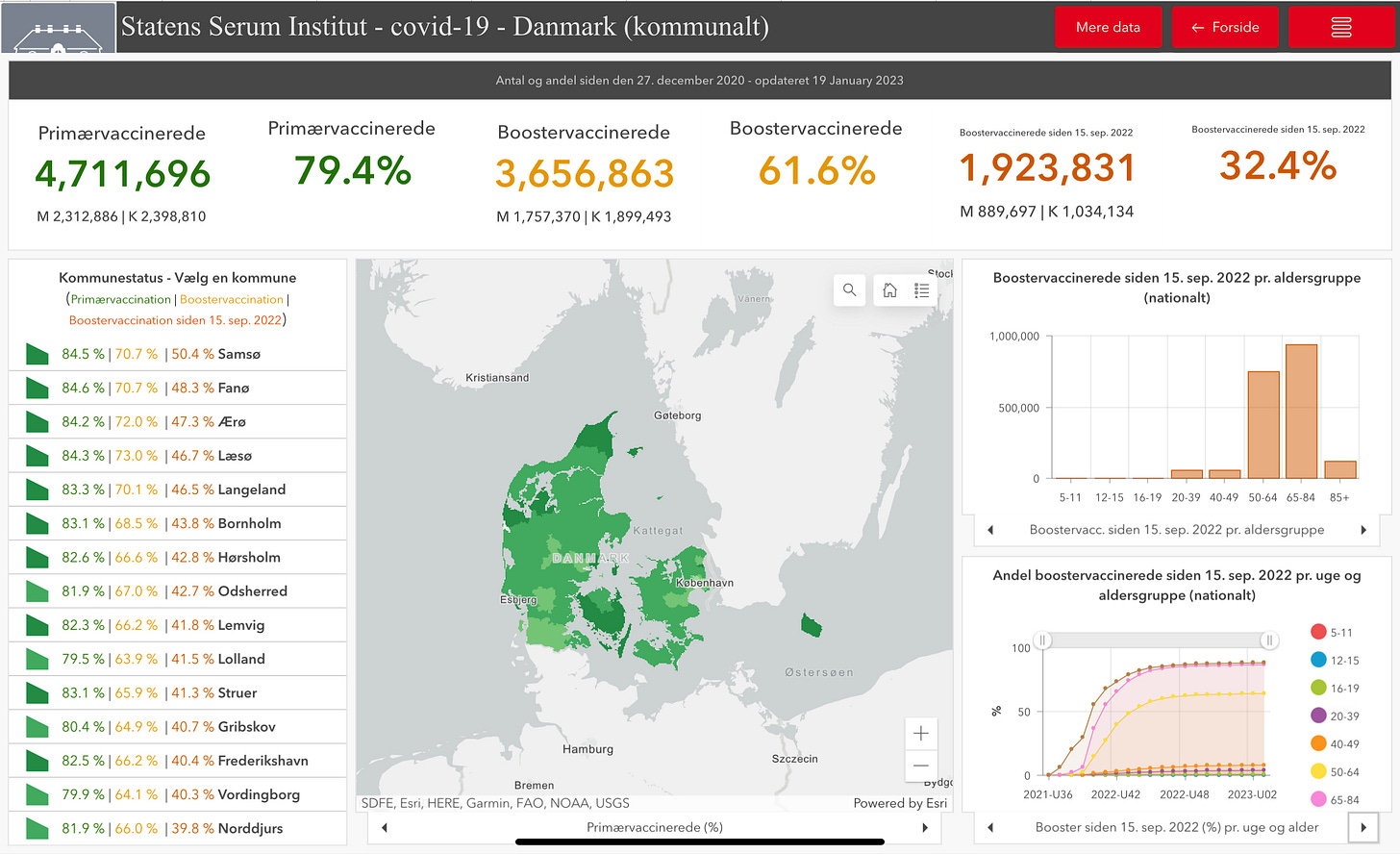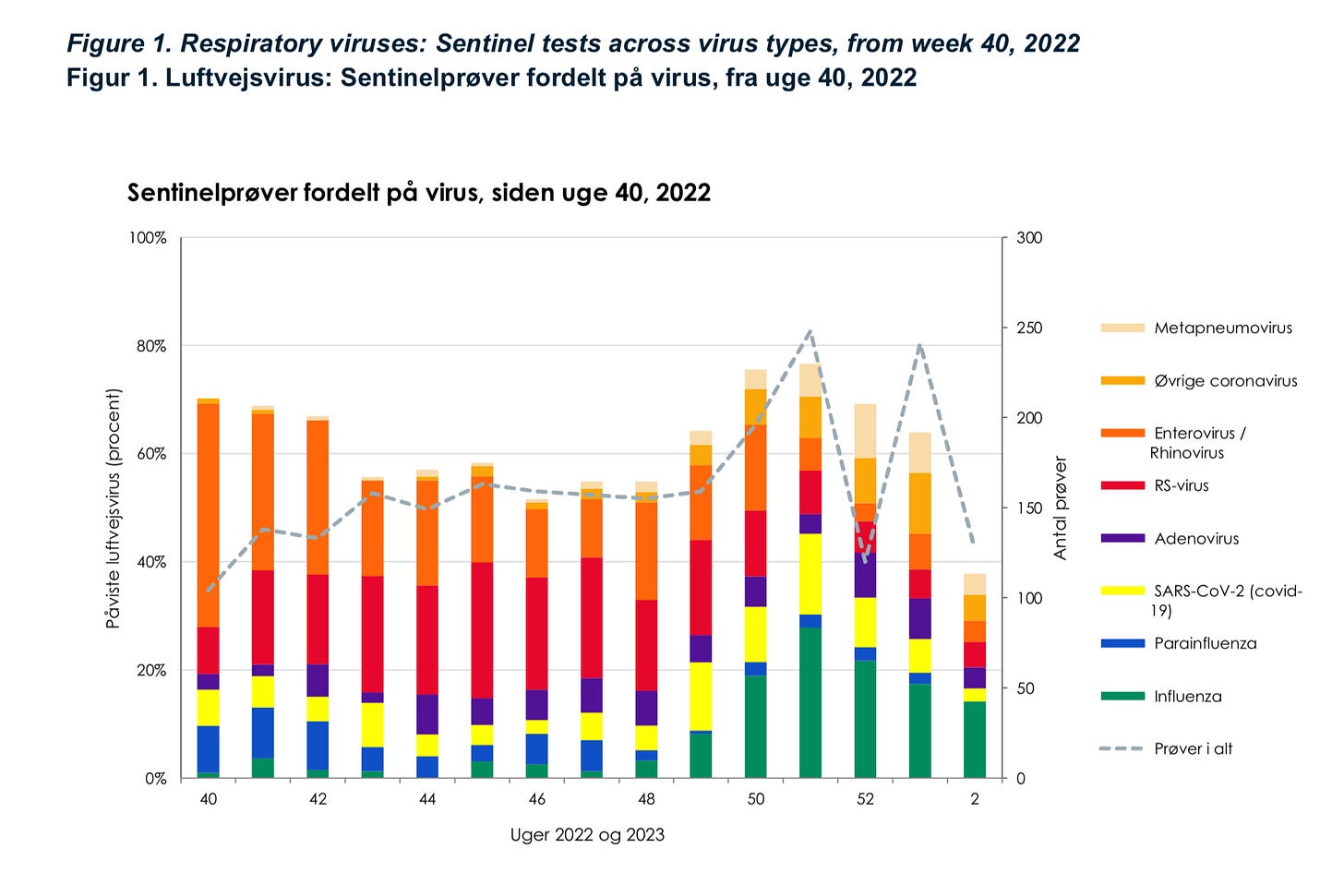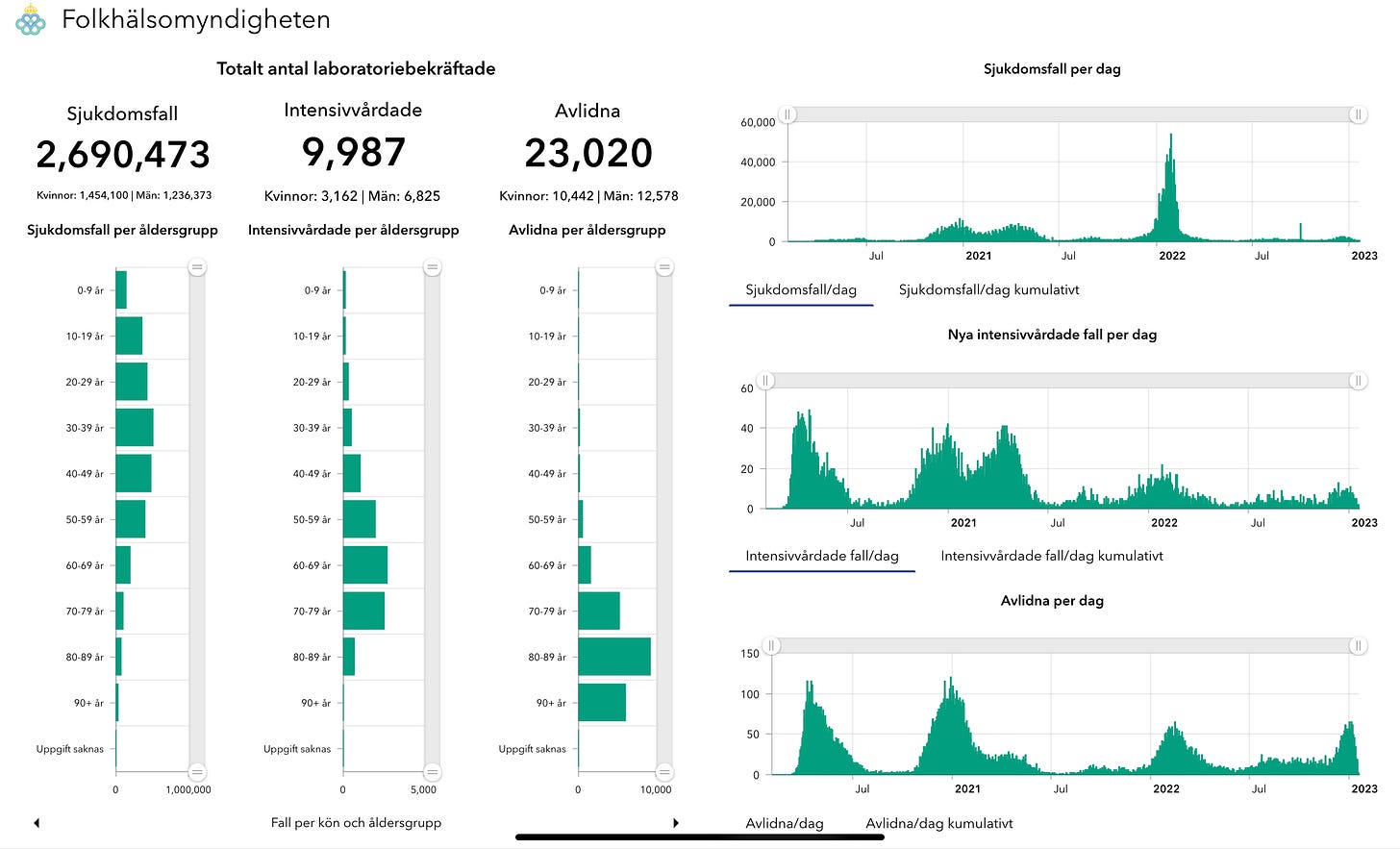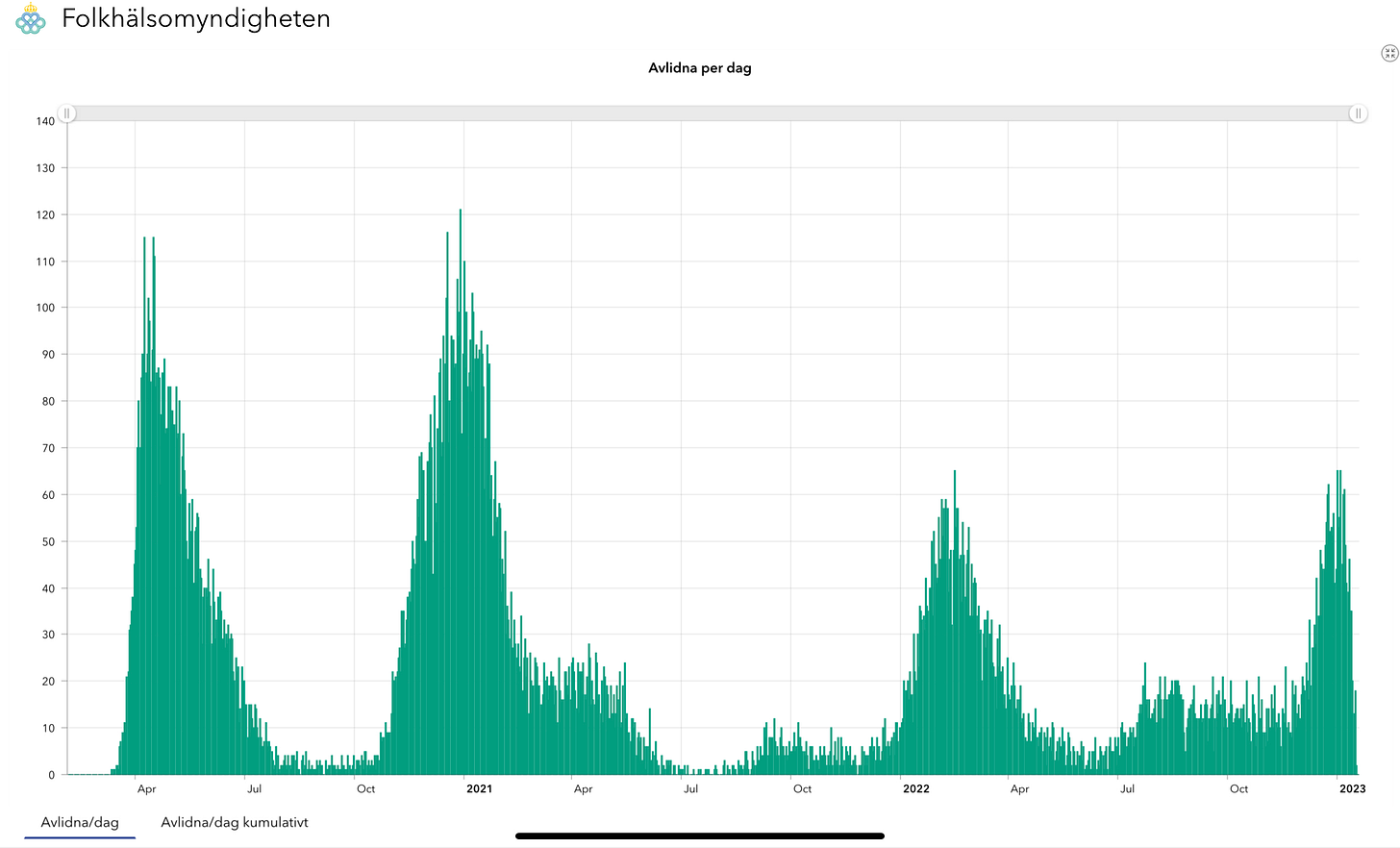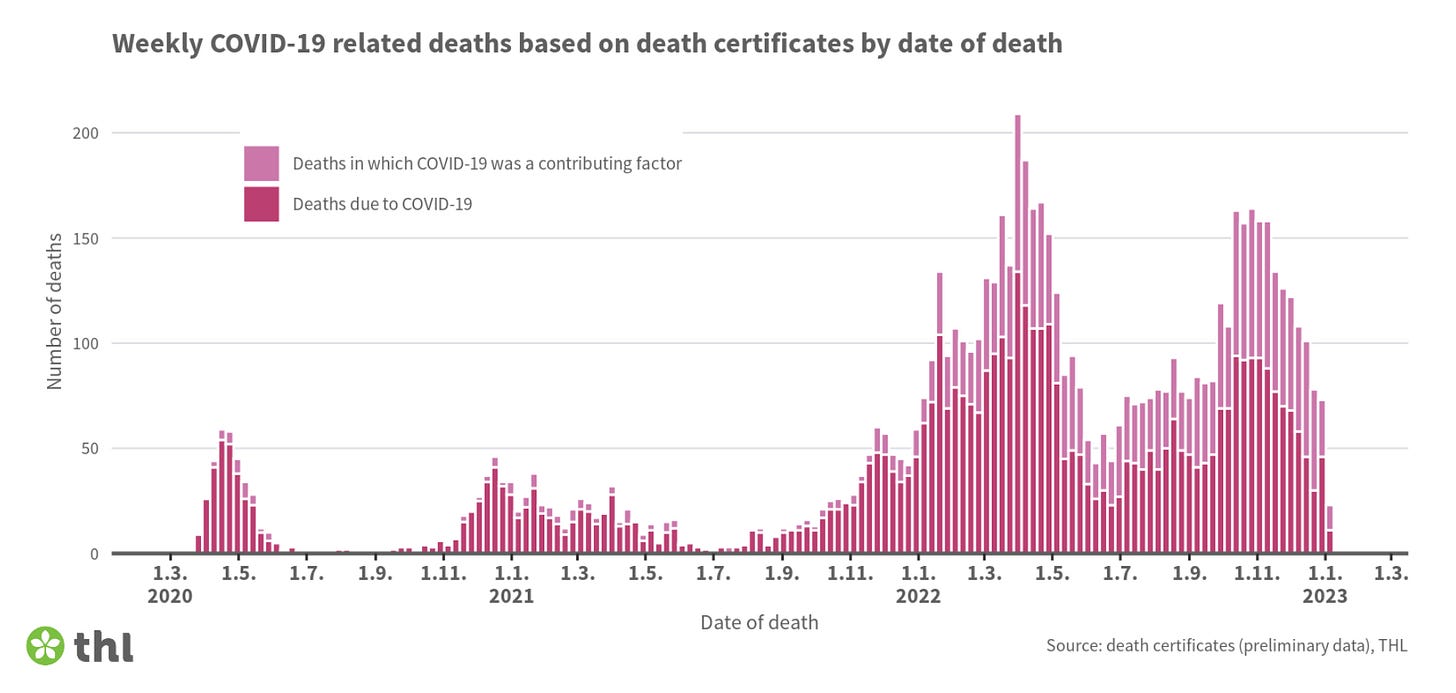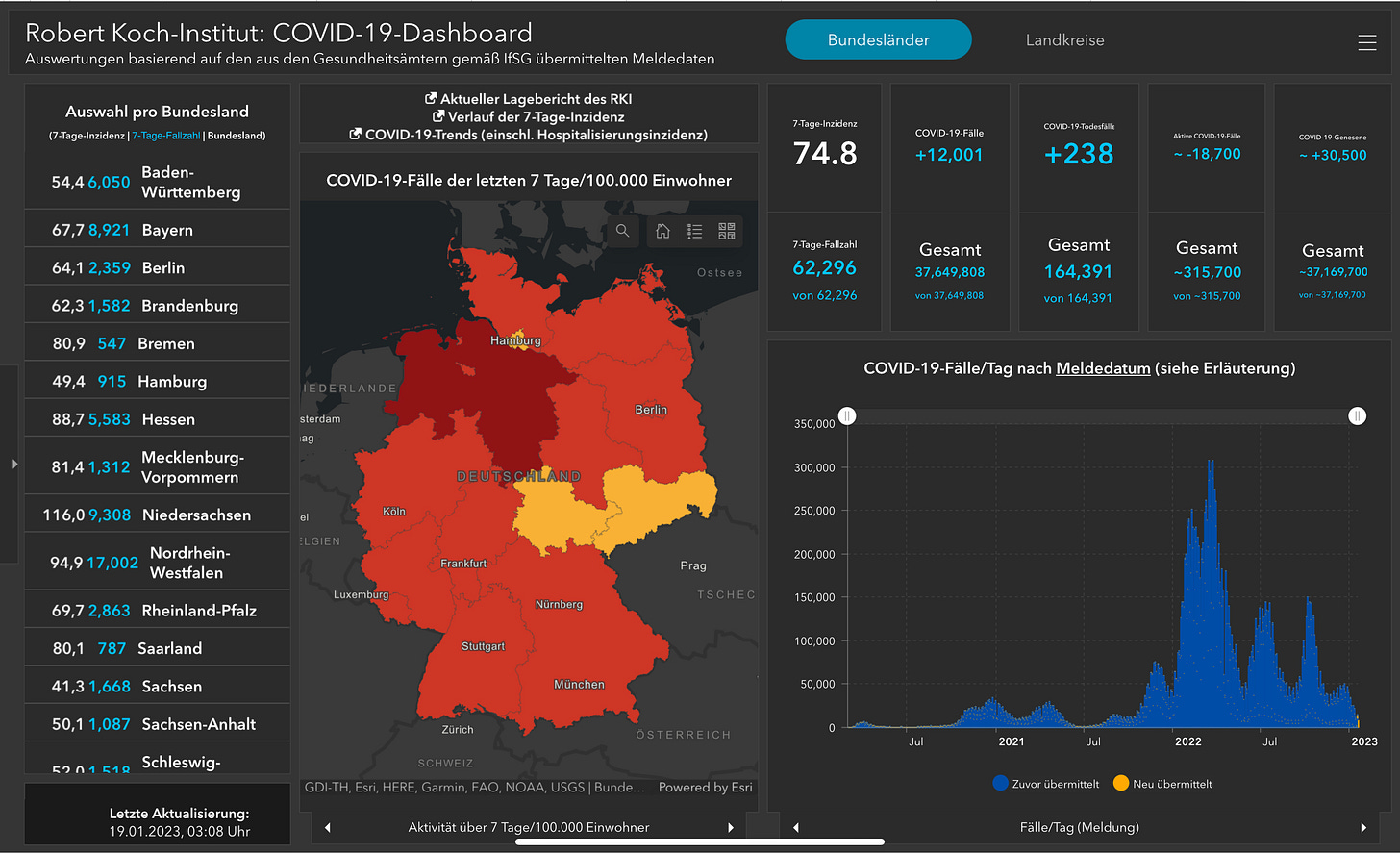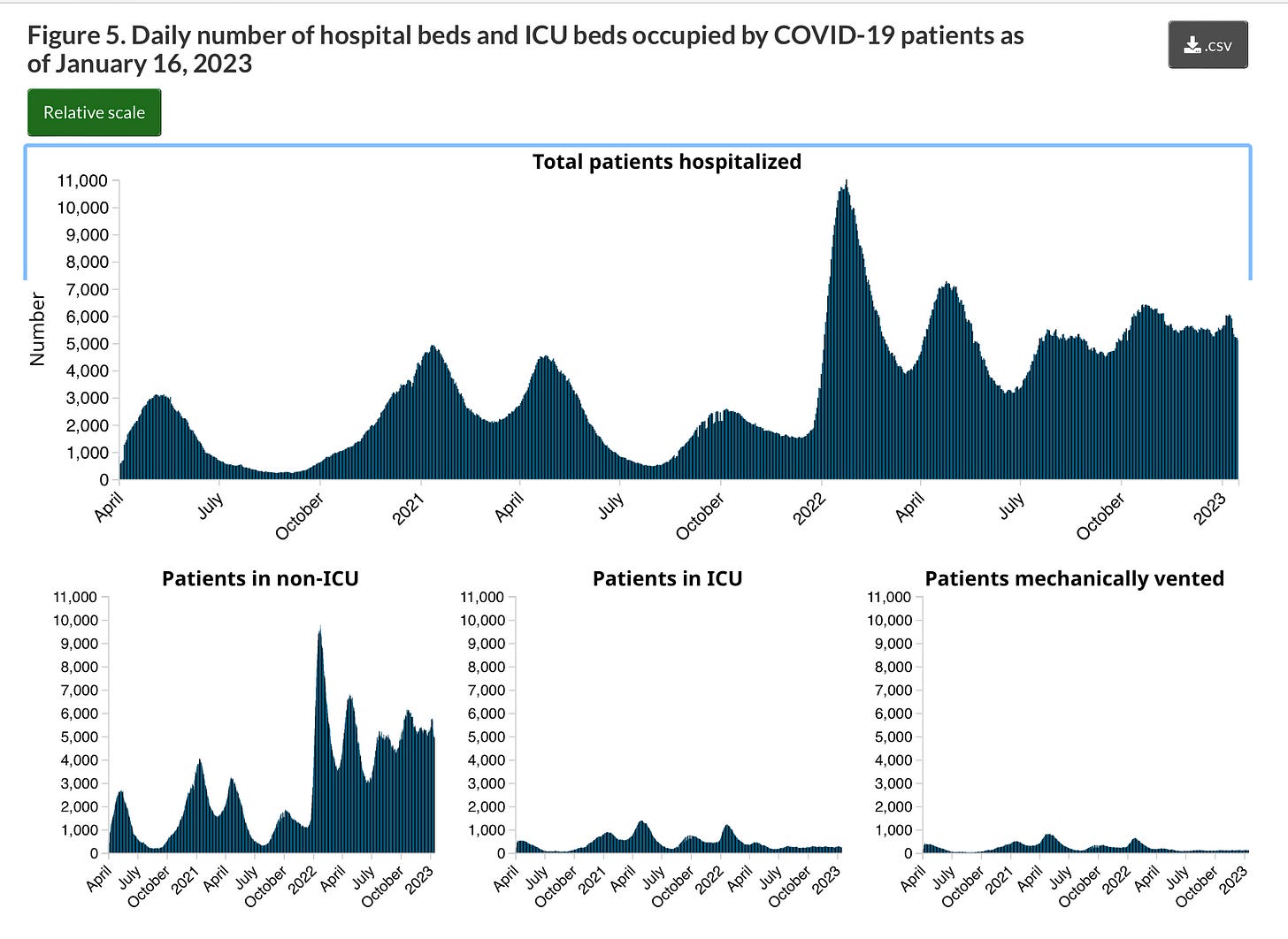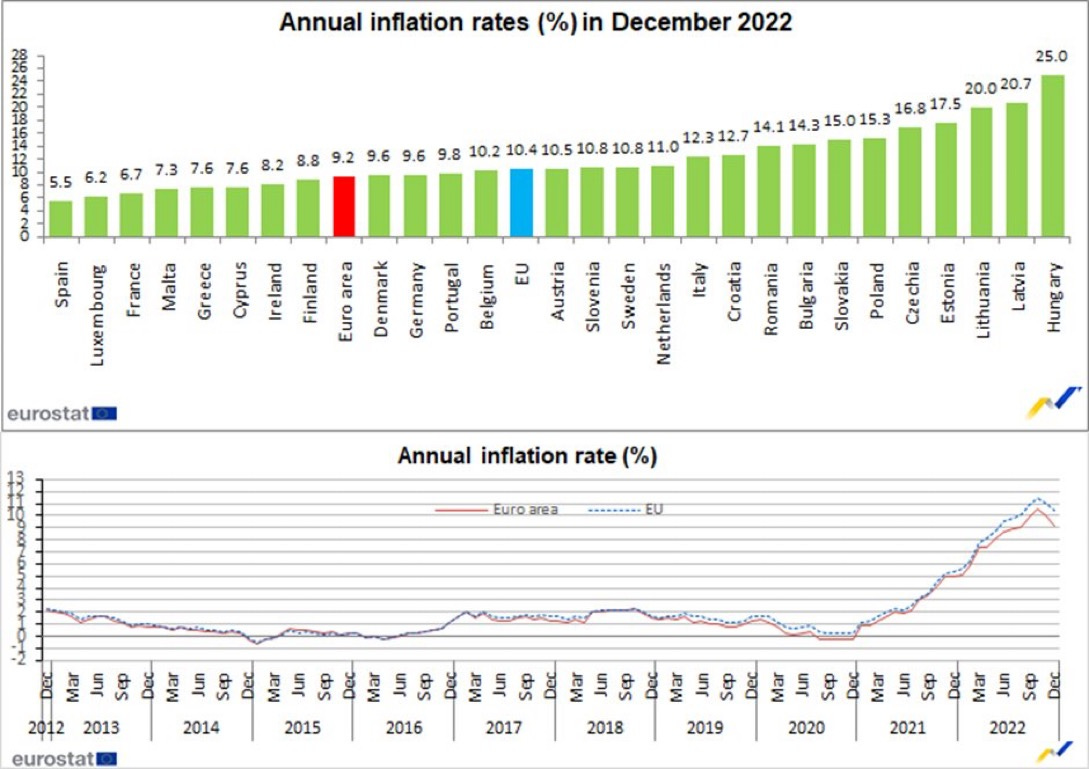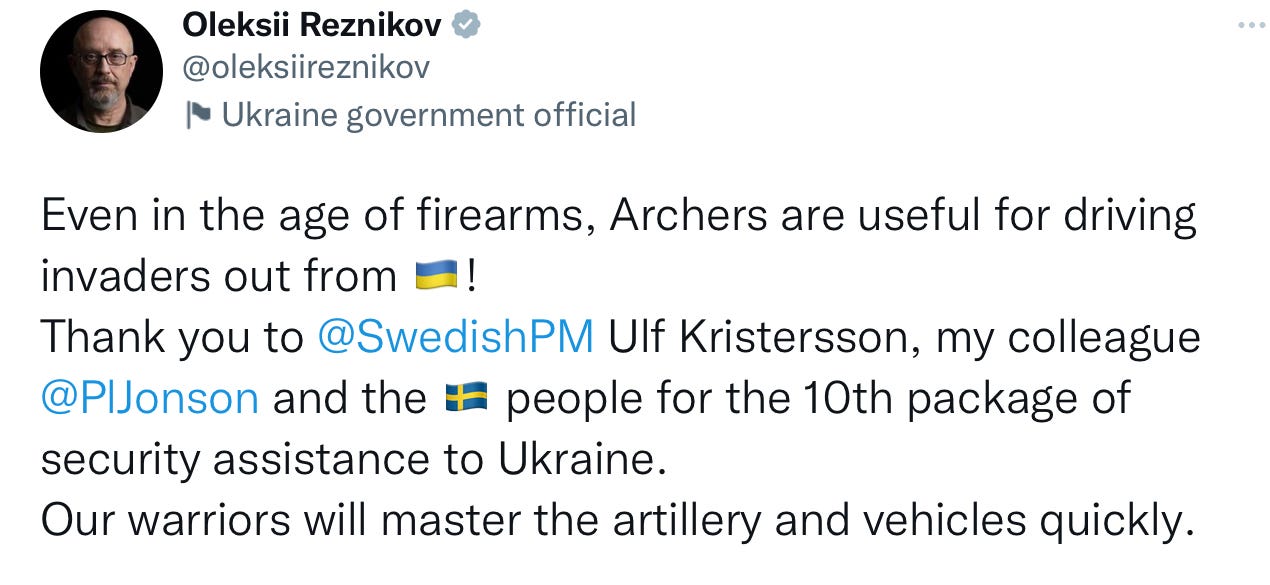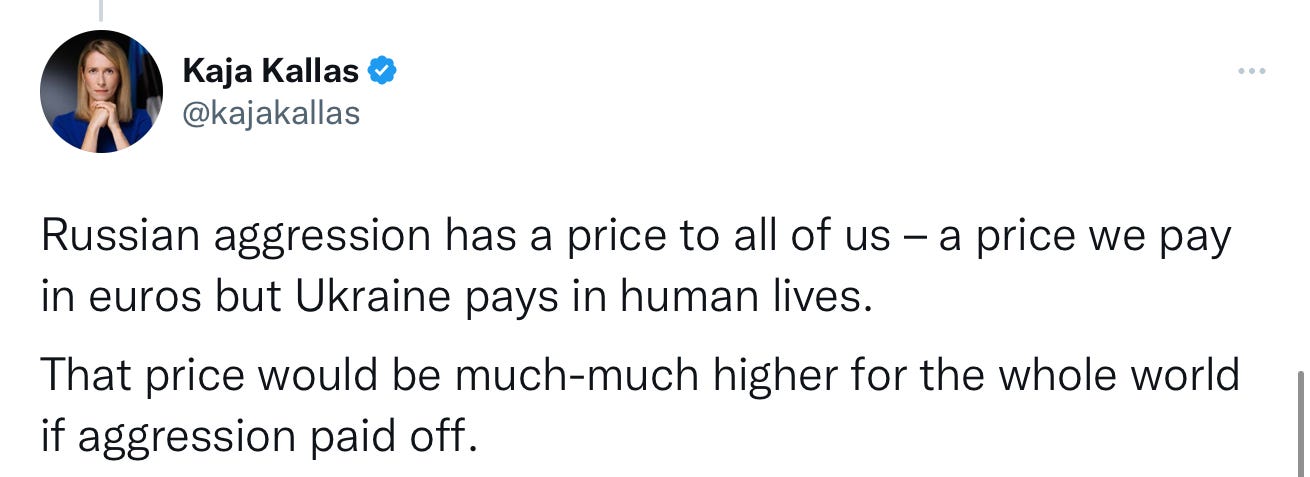🦠Pandemic🦠
🇩🇰
The infection waves, all of them, appear to have broken according to the Statens Serum Institute’s latest weekly assessment.
Chief Physician Bolette Søborg says by every statistical measurement coronavirus activity is in retreat.
“It is gratifying that the COVID wave now seems to have lost its breath. The trend is clear, because we see a decrease in all the places where we measure the infection. It is striking that it has happened so quickly and so significantly, and cannot, for example, be explained by the fact that the weather has improved. There are indications that we have now built up a certain immunity in the population to the virus variants that are currently in circulation.”
The COVID incidence rate per 100,000 people, an unreliable statistic, continued to drop, going from 77 to 35 week to week. But, PCR testing, what little of it that is still being done, also fell by 36% last week. The positivity percentage also dropped from 12.8% to 9.1% from one week to the next. The infection activity is in decline across all five Danish regions.
Looking through the lens of infection activity by age group, coronavirus numbers fell across the board, with the exception of children three to five years old, where a slight increase was recorded last week. It is the same story for the positivity percentage.
-
Among vulnerable seniors in care infections are also falling, and have for three straight weeks now. But, testing rates are also sliding. There were 38 residents with COVID hospitalized last week, down from 43 the week prior. There were 22 fatalities among infected seniors in nursing homes last week, 14 fewer than the week before.
Infection cases among care home staff are also on the decline.
-
COVID hospitalizations, a more reliable pandemic measurement, continue to fall. There were 382 new admissions last week, almost half the number of the week prior. About half (49%) of all patients admitted to hospitals who tested positive were there to be treated specifically for a COVID infection. Seniors 70 to 89 years old continue to make up the largest proportion of new infection-related admissions, as they have for many months.
Looking at the daily hospitalization numbers (332) they continue to plunge (-31) while the number of severe infections in an ICU (18) inched upward (+2) of those, the number on a ventilator (4) is unchanged day to day.
COVID admissions to a psychiatric facility (70) are unchanged.
Infection activity among hospital workers has really dropped, going from 90 per 100,000 people to 34 week to week. The positivity percentage among healthcare workers was chopped almost in half from one week to the next going from 14.1% to 8.6%.
-
Pandemic deaths remain too high in Denmark. There were 90 coronavirus deaths last week, down slightly from the 97 lives lost the week before. The SSI notes excess mortality rates have “continued to be markedly elevated.” Seniors over the age of 75 continue to suffer the highest number of deaths.
On Wednesday, 14 more lives were lost to the virus.
-
Looking at COVID wastewater surveillance data, a more reliable pandemic measurement, virus activity is in decline both nationally and across all five Danish regions. The SSI says over the last three weeks there “has been a sharp drop” in coronavirus activity.
-
BQ.1.1 and its sub-variants are now dominant in Denmark making up about 40% of all sequenced positive tests last week. The BA.2.75 variant is seeing some growth, coming back in 29% of cases. XBB.1.5 was treading water with 27 confirmed infections last week (2.98%).
“What these variants have in common is that they have several common mutations, which mean that they can infect people who have been previously infected or vaccinated to a greater extent than the other variants. There is no evidence that these variants are associated with more severe infections.”
-
On the vaccination front, 32.4% of the total population now has a 2nd booster dose. Of the target group of those 50 years old and older, booster dose uptake is 76%. That rises to 88% among seniors over the age of 85, and to 89% among vulnerable seniors in care.
The SSI says protection from a 2nd booster dose continues to hold up. It estimates those with a 4th dose, among the 50 years old and older target group, are 72% better protected against a severe infection resulting in hospitalization than those with three doses.
-
The SSI says RS virus rates have dropped and influenza cases are also down, albeit to a lesser extent.
But, Chief Physician Bolette Søborg says the true flu infection picture remains a bit uncertain.
“Since there has also been a decrease in testing activity since Christmas, the figures must be interpreted with caution. The flu season usually does not peak until February or March, and it is not uncommon for a decline to be seen over Christmas and New Year. But now it is the second week in a row, so something could indicate that there is actually a real decline. It will be interesting to follow the infection in the coming weeks.”
🇸🇪
Sweden has added 2,633 new infections (wildly underreported) and another 375 corona deaths in the last seven days.
Total to-date pandemic deaths now exceed 23,000, or almost three times that of Denmark, and more have died in Sverige than in Denmark, Norway, and Finland combined.
COVID deaths in Sweden during this latest infection wave are now in a similar neighbourhood as its death toll during the Omicron variant wave in the winter and spring of 2021/22.
COVID hospitalizations have not been updated since last week.
🇳🇴
The infection picture in Norway remains uncertain. In its latest weekly report, the Norwegian Institute for Public Health says COVID, influenza, and RS virus hospitalizations have all declined over the last two weeks. But, it adds, while that is positive news, there is a great deal of uncertainty about how the situation will unfold over the rest of the winter.
With infection rates remaining to high, so many people being out sick, along with “many outbreaks” in senior care homes, and hospitals, that hospitals and municipalities must remain on alert.
The institute continues to urge people who are sick to stay home. It also wants people who are among a vulnerable or high-risk population to use a mask. Anyone visiting a senior care home or any other risk group indoors should also mask up.
The NIPH says while coronavirus, RS virus, and influenza continue to be dominant, overall respiratory infections have been dropping for two straight weeks. Since the last week of 2022 and the first week of the new year, respiratory infection-related hospital admissions fell from 2,843 to 2,090.
The COVID wave is easing in Norway. The NIPH says wastewater surveillance shows a clear decrease in virus activity. The number of infection-related visits to a family doctor or emergency room has also declined.
The number of hospitalizations of people who have tested positive dropped from 439 to 284 from one week to the next. Intensive care admissions fell from 23 in the first week of January to just nine last week. More specifically, hospitalizations directly due to a COVID infection have been cut in half week to week, dropping from 225 to 112.
Pandemic deaths have also fallen, with 53 lives lost last week, 51 fewer than the week before.
The BQ.1.1 variant is dominant in Norway. But a BA.2.75 strain and its sub-variant called CH.1.1.2 are seeing increasing growth. The NIPH says it is concerned that once other respiratory infections die out and there is less interference, then it’s possible these new COVID variants could really take off.
-
The good news is influenza numbers have dropped. This includes infections, flu-related visits to a doctor, and the influenza positivity percentage. The decreases were seen across all municipalities and all age groups except for those five to 14 years old.
Last week, there were 309 influenza hospitalizations, down from 466 the week before. Intensive care numbers fell from 17 to less than five from one week to the next.
So far, 63% of seniors over the age of 65 have a flu shot. There is 34% coverage among high-risk groups 18 to 64 years old. 37% of hospital workers have a flu shot. And, a meager 7.3% of kids under the age of 17 are vaccinated against influenza.
-
As for the RS virus, the institute says the winter wave may have now peaked. Hospital admissions have decreased while infection numbers have remained stable. Most of the RS virus hospitalizations are still children under the age of five. In fact, the positivity percentage among infants under them age of four is 39.9%, a week to week increase.
RS virus-related hospitalizations dropped from 247 to 172 from one week to the next.
The NIPH is cautiously signaling that the RS virus epidemic may be over.
🇫🇮
Finland registered 1,173 new infections and just one pandemic death in the last week, which is a steep decline from fatality numbers over the last handful of weeks.
🇩🇪
Germany recorded 12,001 new infections and 238 more virus deaths in its Thursday update.
It also added another 1,159 hospitalizations, while ICU numbers (850) continued to drop (-48). As a percentage of all intensive care beds in the country, coronavirus patients are using 4%.
WHO🦠
The World Health Organization has issued updated COVID guidelines. It is maintaining its advice for people to mask up in certain situations “irrespective of the local epidemiological situation.”
It recommends mask use for:
Anyone who has been exposed to coronavirus.
Anyone who suspects they might be infected.
Anyone who is at high-risk.
And anyone in a crowded indoor or poorly ventilated space.
The WHO is also now recommending a 10-day quarantine from the day symptoms appear. Previously, it recommended a 13-day isolation. But, for those testing positive who don’t have any symptoms, a five-day quarantine will now suffice.
The WHO adds that there is some evidence, albeit of “very low certainty”, that symptomatic infection cases can infect three times as many people after a five-day isolation than after 10.
The global health agency says evidence now seems to suggest that COVID-infected people who aren’t symptomatic are “much less likely to transmit the virus” than infected people who have symptoms.
As for COVID treatments, the WHO continues its “strong” recommendation for the use of Paxlovid, the COVID treatment pill, for those who are at high-risk of severe infections. It advises pregnant or breastfeeding women to consult a doctor before taking Paxlovid.
It also continues to support the use of two monoclonal antibody COVID treatments, sotrovimab and casirivimab-imdevimab.
🇨🇦
COVID hospitalizations remain high across Canada, but numbers have dropped week to week, according to the latest update from the Public Health Agency of Canada.
In the week ending January 16, the total number of hospital beds being used by a coronavirus patient fell by 898, to 5,115 beds in use. Of those, General admissions saw the largest decline declined from 5,736 to 4,874. The number of severely infected people in an ICU dipped by 36, to 241 patients. While those on a ventilator were also reduced by 13, to 106.
⚡️Energy Crisis⚡️
United Nations Secretary General António Guterres blasted fossil fuel companies at the World Economic Forum in Davos, Switzerland this week. Guterres accused the world’s largest energy companies of putting massive profits before the survival of humanity.
“This insanity belongs in science fiction, even though we know that the melting down of the ecosystem is a scientific fact. Those responsible must be held to account.”
His comments come after it was revealed this week, that scientists at ExxonMobil made remarkably accurate forecasts of the impacts of global warming as far back as the 1970s. This, while the company publicly cast doubt that global warming was even real.
-
Eurozone inflation dipped slightly in December, going from 10.1% to 9.2% from month to month, according to the European Union statistics agency EuroStat.
Among the Nordics, inflation in December was highest in Sweden (10.8%) and lowest in Finland (8.8%).
🇫🇮
People in Finland paid out the nose for electricity last year. Yle is reporting that, on average, people in Finland saw their electricity prices rise by 142%. There is some variation depending on the individual companies and contract type among customers.
🇩🇪
Germany may be moving at light speed in finding alternatives to Russian gas, but it is costing them big time. Figures from Germany’s foreign trade office (BAFA) show that natural gas import costs more than doubled last year, despite imports dropping by 29%. The import bill for natural gas in the first 11 months of 2022 rocketed up to €68 billion compared to €29.4 billion over the same period in 2021.
This is on top of the price tag to set up multiple LNG facilities, soaring energy bills, resulting inflation, and increased greenhouse gas emissions due to falling back on polluting coal-fired power plants to make up the energy shortfall.
🇺🇦/ 🇷🇺 War
The day before the United States hosts some 50 countries in a meeting of the Ukraine Defense Contact Group at the Ramstein Air Base in Germany, a host of new weapons shipments are already being sent to Ukrainian Armed Forces.
🇩🇰
Denmark will donate all 19 of its CEASAR 155mm howitzers to Ukraine. Of the 19 on order, Denmark has reportedly received 14 or 15 already, with the remaining yet to be delivered from the French manufacturer.
Defense Minister Jakob Ellemann-Jensen:
“This is a very large and significant donation. We have been in continuous contact with the Ukrainians about this artillery in particular, and I am happy that we have now received broad support from the Danish Parliament to donate it to Ukraine's struggle for freedom. There is no doubt that it is needed, even if there are still technical issues with the system.”
Ellemann-Jensen says work is underway to rapidly acquire more CAESAR howitzers for the Danish military to replace the ones now going to Ukraine.
“At the same time, we must find a balance between helping Ukraine and continuing to strengthen the Danish defense so that we can safeguard Denmark's security and live up to our obligations in NATO.”
Denmark will also provide training in use of the artillery system and what it called an “education package” along with the donated weapons.
🇸🇪
Swedish Prime Minister Ulf Kristersson said his country would send Ukraine Archer mobile howitzer artillery systems, something Ukraine has asked for, for months. Not done there, Sweden is also shipping to Ukraine, 50 CV-90 armoured vehicles and 90 more NLAW anti-tank weapons.
Kristersson says this is the first part of a three-part military package.
“Military support is decisive. It can change who retakes the initiative this winter"
Sweden hasn’t yet determined how many Archer artillery systems will be sent to Ukraine. The Swedish military has been tasked with doing an inventory to determine how many of the howitzers could be sent.
The news was welcomed by Ukraine’s Minister of Defense.
🇪🇪
Estonian Prime Minister Kaja Kallas announced her government is sending its biggest military shipment yet to Ukraine. It includes anti-tank weapons, ammunition, howitzers, and remote fire weapons. All in the package is worth €113 million.
Estonia will also increase the budget for its military assistance to Ukraine to €370 million, or slightly more than 1% of Estonia’s gross domestic product.
Russian occupation remains a bitter memory among Baltic states. Prime Minister Kaja Kallas says for Estonians the Russian invasion of Ukraine is personal.
“Estonians know from their painful history what happens when evil triumphs and a large country swallows up smaller ones. If Ukraine fell, freedom would also be in danger in other parts of the world. By helping Ukraine to defend its independence, we are defending the right to freedom and democracy of all countries, including Estonia.”
Kallas warns that while everyone wants the war to end, Putin has clearly signaled that Russian aggression will continue. And despite its massive losses on the battlefields of Ukraine, she cautions that Russia still has “thousands of tanks, armoured vehicles, and artillery in its warehouses ready to dash into war.”
Kallas is urging the international community to step up military aid to Ukraine to match the increase in activity from Russia’s war industry.
🇱🇹/ 🇺🇦
Lithuania is also sending another shipment of weapons to Ukraine. It will include two Mi-8 helicopters, dozens of L-70 anti-aircraft guns, and ammunition. This latest weapons shipment will cost €125 million.
🇨🇦
Canada is donating 200 Senator APC armoured personnel carriers to Ukraine. The donation is worth $90 million and is part of the $500 million in military aid to Ukraine that Prime Minister Justin Trudeau announced last fall.
🇵🇱/ 🇩🇪 🇺🇦
Poland has had enough of the dithering from Germany and its policy of incoherence concerning getting Leopard tanks to Ukraine. On his way home from the World Economic Forum, Polish Prime Minister, Mateusz Morawiecki says either Germany does the right thing, and if it doesn’t, Poland will with or without them.
Shipping Leopard tanks requires an export permit from Germany, where they are produced. Germany has been on and off the fence in agreeing, then scuttling plans to get Leopard tanks to Ukraine. Morawiecki has clearly lost patience with Germany and is ready to send a number of Leopard tanks to Ukraine.
Defense Academy Military Analyst Anders Puck Nielsen spoke to DR to say Poland Dan certainly chose to do it on their own, but there could be ramifications.
“[They could] easily put the tanks on a train into Ukraine, but that could have consequences. There are also some contractual challenges with that, and the Ukrainians may run the risk of having some challenges in obtaining spare parts that are produced in Germany.”
🇩🇰/ 🇺🇸
Shipments of American military equipment and armoured vehicles will soon be spotted on the backs of trucks heading down Danish highways bound for Eastern Europe. The equipment has been unloaded from a cargo ship that docked in Aarhus this week. It is going to be used to shore up NATO’s eastern flank.
While the equipment is being shipped out, the Danish military is warning that parts of the Port of Aarhus will be restricted to the public. There will also be American soldiers helping to secure the restricted areas of the port..
This also marks the first time the United States has chosen Denmark as a host country to offload military equipment for transport.
Defense Minister Jakob Ellemann-Jensen:
“Good host nation support for our allies is a very central part of our contribution to NATO's collective defense. The use of Aarhus Harbor is an expression that the US sees potential in Denmark as a host nation for US forces, and in a time when Western values such as freedom and democracy are being challenged, it is absolutely crucial for our security that we stand shoulder to shoulder with our core allies such as the United States.”
🇪🇺/ 🇷🇺
The European Parliament has voted to create a special tribunal to prosecute war crimes committed by Russia in Ukraine. This would include Russian leaders, soldiers, and anyone who was an accessory.
🇸🇪/ 🇷🇺
Two Swedish brothers have been handed long prison sentences for charges of spying for Russia and working as assets of its intelligence agency, the GRU. The oldest of the two, was handed a life sentence, while the younger brother got nine years and 10 months behind bars. The sentences were handed down in Stockholm District Court on Thursday.
Part of the court’s verdict read:
“It is placed beyond reasonable doubt that the brothers, together and in consultation, without authorization and for the benefit of Russia and the GRU, acquired, forwarded and disclosed information" to a foreign power with the purpose of damaging Sweden's national security




